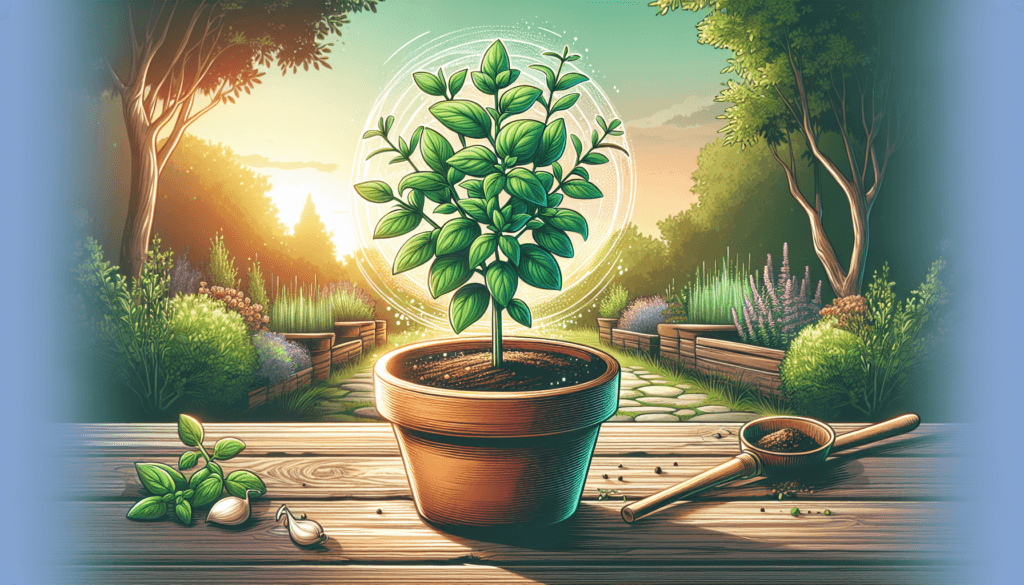Imagine stepping outside into your own oasis of fresh, aromatic herbs. With just a few simple steps, you can learn how to start an organic herb garden right in your own backyard. This article will guide you through the process, from selecting the perfect location to choosing the right herbs for your culinary needs. Get ready to embark on a green journey that will not only enhance your cooking but also bring a sense of tranquility and satisfaction to your everyday life.

Choosing the Right Location for Your Organic Herb Garden
Consider the Sunlight Requirements of Your Herbs
When choosing the location for your organic herb garden, it is essential to consider the sunlight requirements of the herbs you plan to grow. Most herbs thrive in full sun, which means they need at least six hours of direct sunlight each day. Some herbs, such as basil and rosemary, require even more sunlight to flourish. Before deciding on a spot for your herb garden, observe the amount of sunlight the area receives throughout the day to ensure it is suitable for your chosen herbs.
Evaluate the Soil Quality
The next step in choosing the right location for your organic herb garden is to assess the soil quality. Herbs prefer well-drained soil that is rich in organic matter. Take a close look at the soil in the potential garden area. Does it have a loose, crumbly texture? Is it dark and rich in color? These are signs of healthy soil. If the soil is compacted or clay-like, it may hinder the growth of your herbs. Consider amending the soil with compost or other organic matter to improve its structure and fertility.
Assess the Drainage of the Area
In addition to evaluating the soil quality, it is crucial to assess the drainage of the area where you plan to create your organic herb garden. Herbs generally do not tolerate soggy or waterlogged soil. If the chosen location tends to hold water after rain or irrigation, it may be necessary to improve drainage. Consider adding organic matter or creating raised beds to ensure excess water can drain away effectively, preventing root rot and other water-related issues.
Take into Account the Wind Exposure
Lastly, take into account the wind exposure in the chosen location for your organic herb garden. While some airflow is beneficial for preventing disease, excessive winds can cause damage to delicate herb plants. Strong, continuous wind can dry out the soil quickly and lead to dehydration of the herbs. If your selected area is prone to strong winds, consider creating windbreaks or using containers to provide some shelter for your herbs.
Deciding on the Types of Herbs to Grow
Research Different Herbs and Their Characteristics
When deciding on the types of herbs to grow in your organic herb garden, it is essential to do some research on different herbs and their characteristics. Each herb has its own specific growing requirements, including sunlight, soil type, and water needs. Some herbs, like parsley and cilantro, thrive in cooler temperatures, while others, such as oregano and thyme, enjoy warmer conditions. By understanding the individual needs of each herb, you can choose the ones that are best suited for your garden and climate.
Consider Your Personal Preferences and Cooking Needs
In addition to researching the characteristics of different herbs, consider your personal preferences and cooking needs. Think about the herbs you frequently use in your favorite dishes or the ones that you enjoy the aroma of the most. By growing herbs that you personally love, you are more likely to put them to good use in your cooking, making your organic herb garden both practical and enjoyable.
Take into Account the Climate and Growing Conditions in Your Area
Another important factor to consider when deciding on the types of herbs to grow is the climate and growing conditions in your area. Some herbs are better suited for specific climates, while others are more adaptable. For example, Mediterranean herbs like lavender and sage thrive in warm, dry climates, while mint and chives can tolerate cooler temperatures. Make sure to select herbs that are well-suited to the climate and growing conditions of your region to increase their chances of success in your organic herb garden.

Preparing the Soil for Your Organic Herb Garden
Clearing the Area of Weeds and Debris
Before you can start planting your organic herb garden, it is important to clear the area of any weeds and debris. Weeds can compete with your herbs for nutrients and sunlight, potentially hindering their growth. Remove any weeds by hand, making sure to remove the roots as well. Clear away any debris, such as sticks or rocks, that may obstruct the growth of your herbs or interfere with your gardening activities.
Loosening and Aeration of the Soil
Once the area is clear of weeds and debris, it is time to loosen and aerate the soil. This step is crucial for creating a favorable environment for your herb plants’ roots to spread and access nutrients. Use a garden fork or a tiller to gently loosen the soil, breaking up any compacted areas. This process will improve the soil structure and promote healthy root growth.
Testing and Adjusting pH Levels if Necessary
Testing the pH levels of your soil is an important step to ensure optimal conditions for your organic herb garden. Most herbs prefer a slightly acidic to neutral pH range. You can easily test the pH using a soil testing kit or by sending a sample to a local extension office. If the pH levels are not within the desired range for your herbs, you can adjust them by adding amendments such as lime to raise the pH or sulfur to lower it.
Adding Organic Matter and Compost
To further enrich the soil for your organic herb garden, it is beneficial to add organic matter and compost. Organic matter, such as well-rotted manure, compost, or leaf mold, improves the soil structure, provides essential nutrients, and enhances water retention. Spread a layer of organic matter over the cleared and loosened soil, then mix it in thoroughly. This will help create a nutrient-rich environment for your herb plants to thrive.
Starting Herbs from Seeds or Seedlings
Choose High-Quality Organic Seeds or Seedlings
When starting herbs from seeds or seedlings, it is important to choose high-quality organic options. Organic seeds and seedlings are free from harmful chemicals and genetically modified organisms (GMOs), ensuring that your organic herb garden stays true to its principles. Look for reputable seed companies or local nurseries that specialize in organic varieties. This way, you can ensure that the herbs you grow are healthy, safe, and true to their natural form.
Follow the Instructions on the Seed Packet or Nursery Labels
To successfully start herbs from seeds or seedlings, it is crucial to follow the instructions provided on the seed packet or nursery labels. Different herbs may require specific planting depths, spacing, and germination temperatures. It is also important to note whether the herb is considered an annual, biennial, or perennial, as this will determine its lifespan and future care requirements. By following the instructions carefully, you can increase the likelihood of successful germination and the establishment of healthy herb plants.
Sow the Seeds or Transplant the Seedlings
Once you have selected your high-quality organic seeds or seedlings and familiarized yourself with the instructions, it is time to sow the seeds or transplant the seedlings into your prepared soil. Carefully follow the recommended spacing and planting depth, ensuring that each herb has enough room to grow and access the necessary resources. Gently cover the seeds with soil or firm the soil around the transplanted seedlings to provide stability.
Provide Adequate Water and Care for Germination
Germination is a critical stage in the life cycle of herbs, and providing adequate water and care during this phase is essential. After sowing the seeds or transplanting the seedlings, water the soil gently to ensure it is evenly moist. Be mindful not to overwater, as excess moisture can lead to rot or fungal diseases. Monitor the soil moisture regularly and water when needed. Additionally, protect the young herb plants from extreme weather conditions, such as strong winds or heavy rains, to promote healthy growth and establishment.

Organic Pest Control Methods for Your Herb Garden
Encourage Beneficial Insects and Birds
One effective and environmentally friendly way to control pests in your organic herb garden is by encouraging beneficial insects and birds. Many insects and birds feed on pests such as aphids, caterpillars, and snails, helping to naturally keep their populations in check. To attract these allies to your garden, plant flowers that attract beneficial insects, such as marigolds, daisies, and yarrow. Additionally, provide bird feeders or birdhouses to attract birds that feed on insects.
Practice Crop Rotation and Companion Planting
Crop rotation and companion planting are two organic pest control methods that can help prevent the buildup of pests in your herb garden. Crop rotation involves planting herbs or other plants from different families in different areas each year. This disrupts the life cycles of pests and breaks their cycle of infestation. Companion planting involves growing herbs or other plants that repel pests or attract beneficial insects near each other. For example, planting basil near tomatoes can repel pests that commonly affect tomatoes. Research different companion planting combinations to find the ones that work best for your herbs.
Regularly Inspect and Remove Pests by Hand
Regularly inspecting your herb garden and removing pests by hand is another important organic pest control method. By visually inspecting your plants, you can identify and remove pests before they have a chance to cause significant damage. Look for signs of infestation, such as chewed leaves, holes, or sticky residue. Regularly remove pests, such as slugs, snails, or caterpillars, by hand and dispose of them away from your garden. This hands-on approach can effectively control pests without the use of harmful chemical pesticides.
Use Organic Pest Deterrents and Homemade Sprays
If the above methods are not sufficient in controlling pests in your organic herb garden, you can turn to organic pest deterrents and homemade sprays. Some common pest deterrents include neem oil, garlic spray, or insecticidal soap, which can be found at garden centers or easily made at home. These substances act as natural repellents or disrupt the pests’ life cycles without posing harm to beneficial insects or the environment. Always follow the instructions and precautions when using organic pest deterrents or homemade sprays to ensure their effectiveness and safety.
Watering and Irrigation Techniques for Your Herb Garden
Watering Herbs Adequately Based on Their Specific Needs
Proper watering is crucial for the health and vitality of your herb garden. Each herb has specific water requirements, so it is important to water them adequately based on their individual needs. Some herbs, like basil and parsley, prefer consistently moist soil, while others, such as lavender and rosemary, prefer drier conditions. Observe the soil moisture level and the appearance of your herbs’ leaves to determine when to water. Avoid both overwatering and underwatering, as these can lead to stress and health issues in your herb plants.
Avoid Overwatering to Prevent Root Rot
Overwatering is a common mistake that can be detrimental to your herb garden. Excess water can lead to root rot, which causes the roots to become mushy and compromised. To prevent root rot, ensure that the soil has good drainage and avoid keeping the herbs in overly wet conditions for an extended period. Remember that it is better to underwater slightly and allow the soil to dry out a bit between watering than to constantly keep the soil saturated.
Consider Different Irrigation Methods Such as Drip Systems or Soaker Hoses
Using appropriate irrigation methods can help ensure efficient water use and reduce the risk of water-related issues in your herb garden. Consider using drip systems or soaker hoses, which deliver water directly to the soil at a slow rate, allowing it to penetrate deeply. These methods help conserve water by minimizing evaporation and ensure that the roots receive consistent moisture. Avoid using overhead sprinklers, as they can waste water and promote the spread of diseases.
Mulching to Retain Moisture and Reduce Evaporation
Mulching is an effective technique to retain moisture in the soil and reduce evaporation in your herb garden. Apply a layer of organic mulch, such as wood chips, straw, or shredded leaves, around your herbs, leaving a small space around the stems to prevent rot. Mulch helps to regulate soil temperature, suppress weed growth, and conserve moisture. It also adds organic matter to the soil as it breaks down, further enhancing its fertility and structure.

Maintaining a Healthy Organic Herb Garden
Regularly Prune and Harvest Herbs for Optimal Growth
Regular pruning and harvesting are essential maintenance tasks for maintaining a healthy organic herb garden. Pruning helps promote bushy growth and prevents herbs from becoming leggy or woody. Regularly trim back any dead or diseased branches, as well as any excess growth that may crowd the plants. Harvesting herbs on a frequent basis encourages new growth and ensures that the flavors and aromas are at their peak. Use sharp, clean scissors or gardening shears to make clean cuts near a leaf node or stem junction.
Monitor and Address Nutrient Deficiencies
Monitoring your herb garden for nutrient deficiencies is crucial for maintaining optimal growth and health. Nutrient deficiencies can manifest as yellowing leaves, stunted growth, or poor flavor production. By regularly inspecting your herbs and being attentive to their appearance, you can identify nutrient deficiencies early on. To address deficiencies, consider adding organic fertilizers specific to the nutrient needs of your herbs or amending the soil with organic matter or compost. Always follow the recommended application rates and guidelines to avoid overfertilization.
Prevent Overcrowding by Thinning Seedlings and Plants
Overcrowding can lead to competition for resources and hinder the growth of your herb plants. To prevent overcrowding, thin seedlings and plants as needed. When seedlings have grown a few inches tall, carefully remove the extra seedlings, leaving only the healthiest and sturdiest ones. For established plants, thinning involves removing excess growth to maintain adequate spacing, allowing each herb to receive sufficient light, water, and nutrients. Thinning also helps prevent the spread of diseases and improves air circulation around the plants.
Remove Diseases or Infected Plants to Avoid Spreading
Diseases can spread rapidly in an organic herb garden, potentially affecting the health of all your plants. It is crucial to promptly remove any diseased or infected plants to prevent the spread of diseases. Inspect your herbs regularly for signs of diseases such as wilting, yellowing, or the presence of mold or fungal growth. If you notice any signs, carefully remove the affected plant and dispose of it away from your garden. Avoid composting infected plants to prevent the spread of diseases through your compost.
Harvesting and Storing Herbs from Your Organic Garden
Harvest Herbs at the Right Time for Maximum Flavor and Vitality
Harvesting herbs at the right time is important for maximizing flavor and vitality. Each herb has its own optimal harvesting time, which is typically when their essential oils and flavors are at their peak. Harvest herbs in the morning when the moisture content is lower, as this helps preserve the flavors and prevent wilting. Be sure to familiarize yourself with the specific harvesting guidelines for each herb. For leafy herbs, such as basil or cilantro, pinch off individual leaves or cut the stems just above a leaf node. For woody herbs, like rosemary or thyme, trim the stems from the top.
Use Proper Cutting Techniques to Promote Regrowth
Using proper cutting techniques when harvesting your herbs can help promote regrowth and ensure the longevity of your plants. When harvesting leafy herbs, such as parsley or mint, avoid cutting more than one-third of the plant at a time. This allows the herb to continue photosynthesizing and producing energy for regrowth. For woody herbs, like sage or oregano, cut the stems just above the leaf nodes to encourage branching and new growth. By following these techniques, you can enjoy a continuous supply of fresh herbs from your organic garden.
Dry or Preserve Herbs for Year-Round Usage
Preserving your harvested herbs allows you to enjoy their flavors and medicinal properties year-round. One common method of preservation is drying herbs. To dry herbs, tie bundles of stems together and hang them in a warm, well-ventilated area until they are dry and crispy. Alternatively, you can use a dehydrator or oven at a low temperature to speed up the drying process. Once dried, remove the leaves or small stems from the woody ones and store them in airtight containers, away from light and moisture. Another preservation method is freezing herbs, either by chopping them and placing them in ice cube trays with water or oil, or by freezing whole leaves in freezer bags.
Store Herbs in Airtight Containers in Cool, Dark Places
Proper storage is essential for preserving the flavors, aromas, and medicinal properties of your herbs. After drying or freezing your herbs, store them in airtight containers in cool, dark places, such as a pantry or a cupboard. Light, heat, and moisture can deteriorate the quality of herbs, causing them to lose their potency and flavor. Label the containers with the herb name and the date of preservation to keep track of freshness. Stored properly, your herbs can last for several months, allowing you to continue adding their delightful flavors to your culinary creations.

Tips and Tricks for Success in Your Organic Herb Garden
Start with a Small Garden and Expand Gradually
Starting with a small garden and expanding gradually is a wise approach to an organic herb garden. It allows you to focus your efforts, gain experience, and ensure that you can adequately care for your herbs. Begin by selecting a few herbs that you enjoy the most or use frequently in your cooking. As you become more confident and comfortable with herb gardening, you can gradually expand your garden, adding new varieties and experimenting with different combinations.
Regularly Rotate Herb Locations to Prevent Soil Depletion
Regularly rotating the locations of your herbs helps prevent soil depletion and minimizes the risk of disease and pest buildup. Each herb has specific nutrient requirements, and continuously planting the same herb in the same location can deplete the soil of those specific nutrients. By rotating the herb locations, you allow the soil to replenish and reduce the chances of pests and diseases becoming established. Aim to rotate your herbs every year or every growing season, ensuring that each herb occupies a different spot than the previous year.
Experiment with Different Companion Planting Combinations
Experimenting with companion planting combinations can offer several benefits to your organic herb garden. Certain herbs have natural synergies and can help each other by repelling pests, attracting beneficial insects, or improving growth. For example, planting chamomile near mint can help repel aphids, while planting dill near tomatoes can attract pollinators. Research different companion planting combinations and try out various arrangements to find the ones that work best for your specific herb garden.
Keep Detailed Notes and Learn from Each Growing Season
Keeping detailed notes and learning from each growing season is a valuable practice in maintaining a successful organic herb garden. Record important information, such as planting dates, harvest yields, observation of pests or diseases, or any changes in growing conditions. These notes can help you track trends, identify successes or challenges, and make informed decisions for future planting and care. By continuously learning and adapting, you can improve the overall health and productivity of your organic herb garden.
Conclusion
Starting and maintaining an organic herb garden can be a rewarding and fulfilling experience. By choosing the right location, selecting suitable herbs, preparing the soil, starting from seeds or seedlings, implementing organic pest control methods, applying proper watering techniques, and regularly maintaining and harvesting your herbs, you can enjoy a bountiful supply of fresh, flavorful, and medicinal herbs. Remember to utilize the tips and tricks provided, and always keep an open mind to experimentation and learning. With dedication and care, your organic herb garden will thrive and provide you with an abundant source of natural goodness. Happy herb gardening!


